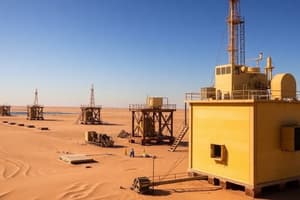Podcast
Questions and Answers
Which country borders the Persian Gulf to the north?
Which country borders the Persian Gulf to the north?
- Oman
- Kuwait
- Iraq (correct)
- Saudi Arabia
Which ancient ports in the Persian Gulf region were important centers of maritime trade?
Which ancient ports in the Persian Gulf region were important centers of maritime trade?
- Dubai and Abu Dhabi
- Bahrain and Oman (correct)
- Kuwait and Saudi Arabia
- Qatar and Bahrain
Which global power established a presence in the Persian Gulf in the late 19th century?
Which global power established a presence in the Persian Gulf in the late 19th century?
- France
- Russia
- British Empire (correct)
- Germany
When was the United Arab Emirates formed?
When was the United Arab Emirates formed?
Who led the coalition of 34 nations during the Gulf War?
Who led the coalition of 34 nations during the Gulf War?
Which country invaded and annexed Kuwait leading to the Gulf War?
Which country invaded and annexed Kuwait leading to the Gulf War?
Shah Ismail I was the founder of the Safavid Empire in 1602.
Shah Ismail I was the founder of the Safavid Empire in 1602.
The Safavid Empire officially adopted Twelver Shia Islam as its state religion.
The Safavid Empire officially adopted Twelver Shia Islam as its state religion.
Tabriz was the first capital of the Safavid Empire.
Tabriz was the first capital of the Safavid Empire.
Shah Abbas I ruled over the Safavid Empire from 1587 to 1629.
Shah Abbas I ruled over the Safavid Empire from 1587 to 1629.
The Safavid Empire reached its greatest territorial extent under Shah Ismail I.
The Safavid Empire reached its greatest territorial extent under Shah Ismail I.
The Safavid Empire was established in the late 17th century by Shah Ismail I.
The Safavid Empire was established in the late 17th century by Shah Ismail I.
Under the rule of Shah Abbas I, the Safavid Empire saw significant expansion.
Under the rule of Shah Abbas I, the Safavid Empire saw significant expansion.
The empire was invaded by the Ottomans and Russians in the 18th century, significantly weakening it.
The empire was invaded by the Ottomans and Russians in the 18th century, significantly weakening it.
The Safavid Empire collapsed in 1722 due to invasions by the Mughals.
The Safavid Empire collapsed in 1722 due to invasions by the Mughals.
Twelver Shia Islam was established as the state religion of Iran during the Safavid Empire and remains dominant in Iran today.
Twelver Shia Islam was established as the state religion of Iran during the Safavid Empire and remains dominant in Iran today.
Flashcards are hidden until you start studying
Study Notes
HLO is not a term that is widely used or referred to in the search results. However, I can provide information on the history of the Persian Gulf region and the Gulf War.
History of the Persian Gulf:
The Persian Gulf is a vital waterway that has been strategically important since ancient times. It is bordered by Iran to the north, Iraq to the west, Kuwait, Saudi Arabia, and Bahrain to the south, and the United Arab Emirates (UAE), Qatar, and Oman to the east. The region has been a center of trade and cultural exchange for millennia, with the ancient ports of Bahrain and Oman being important centers of maritime trade.
The British Empire established a presence in the Persian Gulf in the late 19th century, with the creation of the Trucial States and the establishment of protectorates over Kuwait and Bahrain. Post-World War II, the region saw rapid development, with the discovery of oil in the late 1950s leading to significant economic growth. This period saw the formation of the United Arab Emirates in 1971 and the establishment of the Gulf Cooperation Council (GCC) in 1981, which aims to promote cooperation and unity among its members.
The Gulf War:
The Gulf War, also known as the First Gulf War, was a conflict between Iraq and a coalition of 34 nations, led by the United States, between August 1990 and February 1991. The war began when Iraq, under the leadership of Saddam Hussein, invaded and annexed Kuwait. The international community, particularly the United States, responded with a military intervention to reverse the Iraqi occupation of Kuwait.
The war was fought primarily on land, with U.S. military forces leading the coalition's ground offensive. The conflict was relatively brief, with Kuwait being liberated within 100 hours of the ground invasion. However, it had significant long-term consequences, including the destabilization of Iraq and the eventual U.S. invasion in 2003.
In conclusion, while the search results did not provide specific information on the term "hlo," they do provide a wealth of information about the history of the Persian Gulf region and the Gulf War.
Studying That Suits You
Use AI to generate personalized quizzes and flashcards to suit your learning preferences.




